Measuring gemstone refractive index (RI) values gives you a unique fingerprint for identification, helping you distinguish between similar-looking stones like ruby and spinel. This scientific measurement reveals how light behaves inside the gem, directly affecting its brilliance and sparkle. You’ll use specialized equipment like refractometers to determine if a stone has single or double refraction. These objective measurements prove authenticity, detect treatments, and provide essential data for accurate valuation.
The Scientific Principles Behind Refractive Index

When light travels through a gemstone, it slows down considerably compared to its speed in a vacuum, creating the optical property we call refractive index (RI). This measurement provides you with essential data for gem identification, as each stone possesses a unique RI value or range.
Most gems exhibit double refraction, splitting light into two beams with different velocities. The difference between these two measurements, known as birefringence, ranges from .003 to .287 and offers another distinctive identifier.
Birefringence—nature’s fingerprint in gemstones—reveals itself when light divides, creating unique optical signatures for precise identification.
For example, a diamond’s singular RI of 2.42 contrasts sharply with emerald’s range of 1.565-1.602.
To capture these precise refractive measurements, gemologists use a specialized tool called a refractometer, which works on the principle of total internal reflection—transforming light behavior into quantifiable data for accurate stone analysis.
Key Equipment for Measuring Gemstone RI Values
Three essential tools form the foundation of accurate refractive index measurement in gemology. The refractometer stands as your primary instrument, allowing you to determine if a gemstone’s refractive index is one value or a range between two values.
Every measurement using this key equipment requires proper contact liquid to create the optical connection between the gemstone and the refractometer’s hemicylinder.
- Standard gemological refractometers (GemPro, Eickhorst) – provide readings to 0.001 precision
- Contact liquid – creates necessary optical contact for accurate readings
- Sodium light source (589.3nm) – guarantees standardized, consistent measurements
- Polarizing filter – helps identify doubly refractive materials and determine optic sign
You’ll find these instruments indispensable for distinguishing between similar-looking gemstones with close RI values.
Single vs. Double Refraction in Gemstone Identification
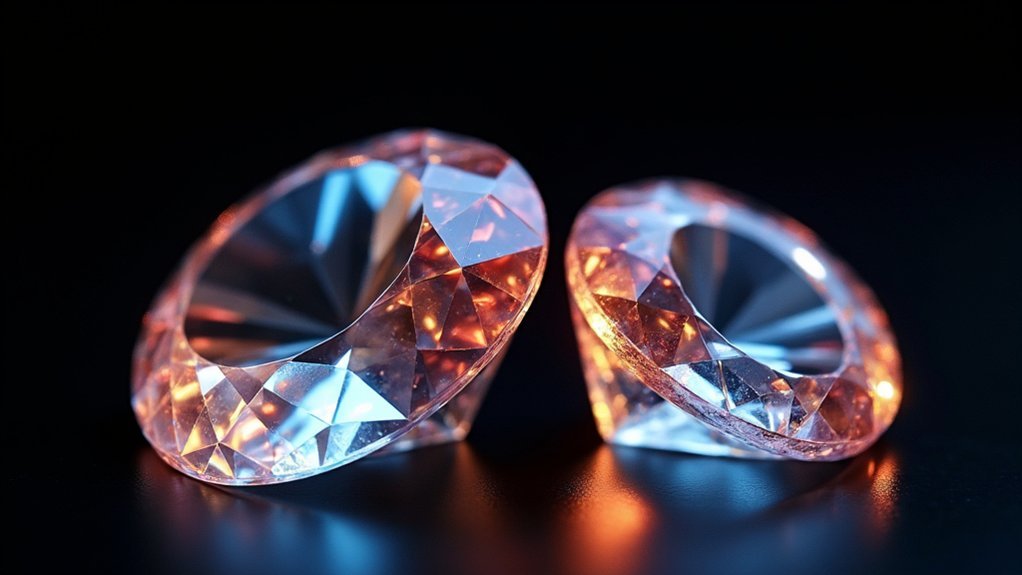
You’ll find that distinguishing ruby from spinel requires understanding their fundamental optical differences, with ruby displaying double refraction while spinel remains singly refractive.
Measuring birefringence—the numerical difference between a gemstone’s two refractive indices—can be accomplished using a refractometer with polarizing filters or a specialized calcite plate.
Clear optical character indicators include the doubling of pavilion facet junctions visible through the crown of doubly refractive stones and the presence of pleochroism, which you won’t observe in isotropic materials like diamond, garnet, and spinel.
Distinguishing Ruby From Spinel
How can gemologists definitively separate genuine rubies from their spinel lookalikes? The answer lies in their distinct refractive indices and optical properties.
When identifying a gemstone, you’ll find that rubies are doubly refractive (1.762-1.778), while spinels are singly refractive (1.712-1.782).
With a refractometer, you can observe these critical differences:
- Rubies show two distinct RI readings due to their double refraction
- Spinels display only one RI reading regardless of orientation
- When looking through a ruby, you’ll see doubled back facet lines
- Birefringence (the difference between a ruby’s two RI values) provides conclusive evidence
These optical characteristics allow you to confidently distinguish between these red gems, ensuring proper identification and valuation in the marketplace.
Birefringence Measurement Techniques
The fundamental difference between singly and doubly refractive gemstones creates one of gemology’s most powerful identification tools. When you’re examining a specimen, this property becomes essential for accurate identification.
Using a refractometer, you’ll observe how doubly refractive gemstones display two distinct refractive indices, with birefringence values ranging from 0.003 to 0.287. The measurement represents the numerical difference between these two indices.
In contrast, singly refractive gems like diamond and spinel show only one reading.
For more detailed analysis, determine the optical sign (+ or -) of doubly refractive gemstones by observing the orientation of ordinary and extraordinary rays.
A dichroscope can further confirm birefringence by revealing color differences as light passes through the stone, helping you distinguish between similar-looking gems with different optical properties.
Optical Character Indicators
When light passes through a gemstone, its behavior reveals one of the most distinctive properties for identification: optical character.
You’ll need to determine whether your gem is singly refractive (isotropic) or doubly refractive (anisotropic) to properly identify it.
- Singly refractive gems like diamond (RI 2.42) and garnet transmit light uniformly with a single refractive index.
- Doubly refractive gems such as ruby and emerald split light into two rays with different speeds and paths.
- Birefringence values (the difference between the two RIs) range from 0.003 to 0.287 in common gems.
- Dichroscope testing allows you to observe different colors along different crystal directions, confirming double refraction.
This optical character assessment is vital for gem identification, especially when distinguishing between similar-looking stones that exhibit different light behavior.
How Refractive Index Reveals Gemstone Authenticity
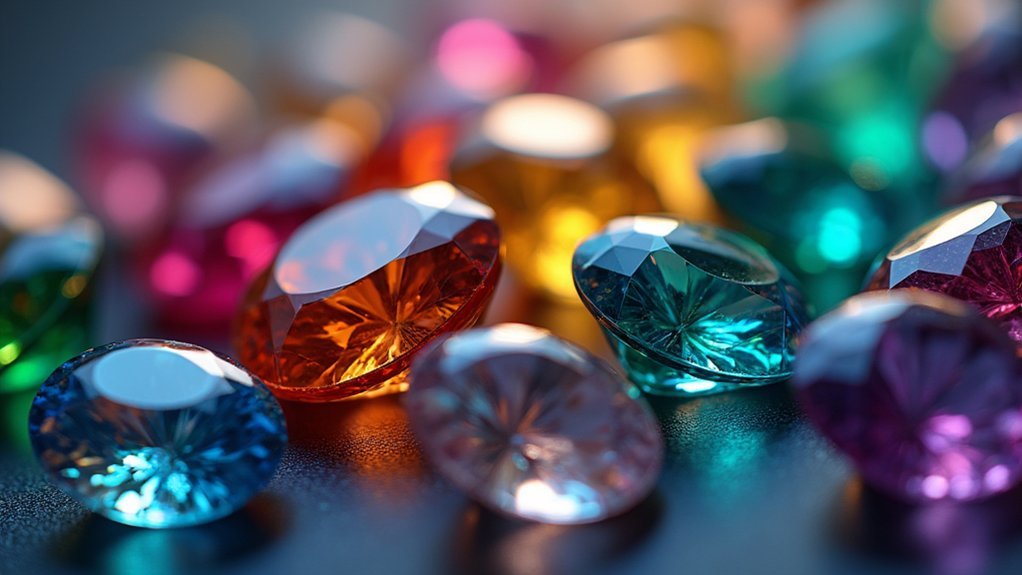
Identifying genuine gemstones from clever imitations largely depends on understanding their optical properties—particularly their refractive index (RI). When you’re examining a stone, its RI value serves as a fingerprint that can confirm or deny its authenticity.
| Gemstone | RI Value | Optical Character |
|---|---|---|
| Diamond | 2.417-2.419 | Singly refractive |
| Ruby | 1.762-1.778 | Doubly refractive |
| Emerald | 1.565-1.602 | Doubly refractive |
| Cubic Zirconia | 2.15 | Singly refractive |
You’ll find that genuine gemstones consistently fall within specific RI ranges. A refractometer precisely measures these values, allowing you to compare results against established standards. This technique is especially valuable for identifying color-change stones like alexandrite, where optical properties confirm authenticity against synthetic alternatives.
The Relationship Between RI and Gemstone Brilliance
Your gemstone’s brilliance directly stems from its refractive index, which governs how effectively it manages light entering and reflecting within its structure.
Higher RI values create smaller critical angles, forcing more light to reflect internally rather than escape through the pavilion facets.
You’ll notice this enhanced light management in gems like diamond (RI 2.42), where the spectacular brilliance results from light being repeatedly bounced and returned to your eye rather than passing through the stone.
Light Management Properties
Although often overlooked by casual observers, a gemstone’s refractive index fundamentally determines its ability to manage light and create that coveted brilliance we admire.
When you’re examining gemstones, understanding how light interacts with them reveals why some sparkle more intensely than others.
- Higher refractive index values (like diamond’s 2.42) create superior brilliance through enhanced light manipulation.
- Doubly refractive gems split incoming light into two separate beams, producing complex visual effects.
- Birefringence measurements reveal how differently these split beams travel, directly affecting the gem’s appearance.
- Even minor RI differences between similar-looking stones can dramatically change their perceived beauty and value.
You’ll appreciate why gemologists rely on precise RI measurements when distinguishing between gemstones that might otherwise appear identical to the untrained eye.
Critical Angle Impact
When light strikes a gemstone, its refractive index directly determines the critical angle—that precise threshold where light either reflects internally or escapes the stone.
This relationship profoundly impacts a gem’s brilliance and overall visual appeal.
You’ll notice that diamonds, with their exceptionally high RI of 2.417-2.419, exhibit extraordinary sparkle because their critical angle encourages more internal reflection.
This means less light escapes through the pavilion, resulting in that coveted brilliance collectors seek.
Materials like ruby and sapphire showcase another fascinating property—they’re double refractive, splitting light into two separate beams.
This characteristic enhances both their brilliance and color saturation.
Practical Applications of RI in Gemstone Valuation
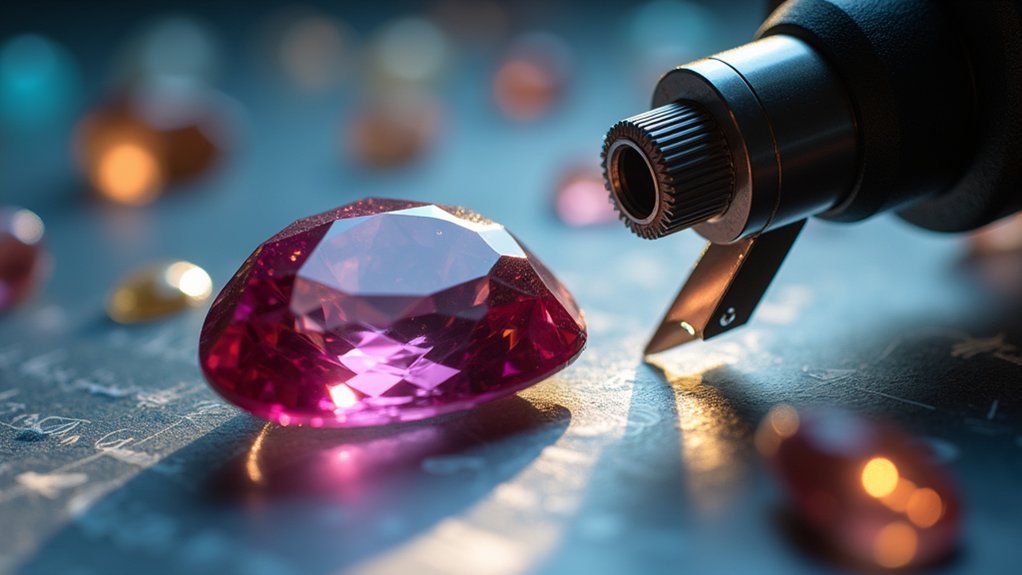
Five key applications make refractive index measurement essential in gemstone valuation. When you’re determining a stone’s market value, the RI provides critical data that directly impacts its worth.
Refractive index measurement provides objective data critical for determining a gemstone’s true market value and authenticity.
You’ll find this measurement indispensable when you need to identify gemstones with similar appearances but vastly different values.
- Authentication – Distinguish natural gems from simulants that may look identical to the naked eye
- Treatment detection – Identify stones that have undergone enhancement processes that alter their original properties
- Brilliance evaluation – Higher RI values generally indicate stones with superior light performance and visual appeal
- Definitive identification – Accurately classify ambiguous specimens like ruby versus spinel, preventing costly valuation errors
The refractive index serves as your objective benchmark when evaluating a gemstone’s true market value.
Common Challenges in Refractive Index Measurement
When measuring gemstone refractive indices, you’ll encounter several technical hurdles that can impact your results.
Your refractometer may fail to measure extremely high RI values, creating identification challenges between diamonds and their simulants.
Surface imperfections, oil residues, and air bubbles between the stone and the refractometer can distort your readings, making proper sample preparation essential for accurate determinations.
Refractometer Limitations
Although refractometers are essential tools for gemologists, they come with several notable limitations that can affect measurement accuracy.
When you’re working with these instruments, understanding their constraints is vital for proper gemstone identification.
- High refractive indices – Low-cost refractometers often can’t measure gemstones with RI values above 1.81, making it difficult to distinguish authentic gems from simulants like diamond.
- Contact issues – Air bubbles or insufficient contact liquid disrupt light refraction, leading to inaccurate readings.
- Inconsistent measurements – Gemstones with complex internal structures or inclusions may show varying refractive indices.
- Environmental factors – Both lighting conditions and precise stone alignment greatly impact your results, with even slight misalignments producing misleading values.
Surface Condition Issues
Gemstone surfaces directly impact the accuracy of refractive index measurements in critical ways. When you’re trying to obtain accurate readings, scratches, dirt, or chemical residues create air gaps that distort light transmission through the stone.
You’ll need to verify your specimen is thoroughly cleaned and polished before testing. Even microscopic contaminants can lead to significant measurement errors, as they interfere with the critical angle reflection that determines refractive index values.
Pay attention to chips or uneven surfaces that alter the angle of measurement. Always use appropriate contact liquid to eliminate air bubbles between the gem and refractometer—these tiny pockets of air are major culprits in producing false readings.
Regular calibration of your equipment helps minimize instrument-related errors that could compound surface condition issues.
Interpreting Unclear Readings
Despite careful preparation, you’ll inevitably encounter ambiguous refractive index measurements that challenge your gemstone identification skills. When faced with unclear readings, consider these common causes:
- Air bubbles trapped between the gemstone and refractometer, distorting light paths and producing false readings.
- Inclusions within the stone scattering light and obscuring the vital shadow edge needed for accurate measurement.
- Similar RI values between different gem species, requiring additional birefringence measurements to differentiate between them.
- Lighting inconsistencies from using incorrect light sources instead of standard sodium light.
Remember that refractometer cleanliness and proper calibration are essential for reliable results.
When standard readings remain ambiguous, turn to complementary testing methods rather than relying solely on potentially misleading refractive index values.
Historical Development of RI Testing Methods
While ancient Greeks like Euclid and Ptolemy first documented light refraction in the 2nd century AD, it wasn’t until the 17th century that Willebrord Snellius formalized Snell’s Law, giving us the mathematical foundation for refractive index.
The precision of refractive index measurements improved dramatically with Pedro Nunes’ vernier scale in the 16th century, later refined by Pierre Vernier.
This technological advancement set the stage for the 19th century’s breakthrough—the refractometer—which revolutionized gemstone analysis by enabling direct optical property measurements.
Birefringence Values and Their Significance
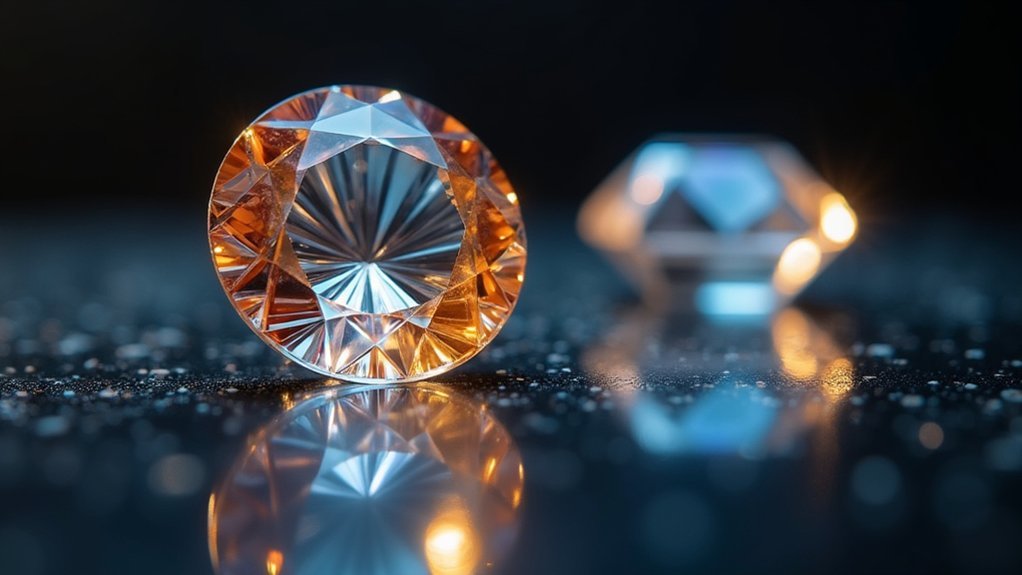
When light passes through certain crystalline materials, it splits into two separate rays traveling at different velocities, creating the optical phenomenon known as birefringence. This difference between refractive indices serves as an essential diagnostic tool in gemstone identification.
You’ll find birefringence values ranging from subtle (0.003) to dramatic (0.287), each revealing important optical properties unique to specific gems.
Four key insights about birefringence:
- Higher values indicate greater optical complexity, helping you distinguish between similar-looking gemstones.
- Amethyst’s low birefringence (0.009) contrasts sharply with azurite’s high value (0.110).
- Specific measurements for gems like agate (0.004) and ruby (0.008) aid in precise classification.
- Double refraction in alexandrite and emerald provides distinctive birefringence values that prevent misidentification.
Gemstone RI Charts and Reference Materials
Gemstone RI charts serve as the backbone of modern gemological identification, organizing refractive index values into accessible reference systems that build upon our understanding of birefringence.
You’ll find thorough listings of refractive values for gemstones ranging from diamond (RI 2.42) to quartz (RI 1.54-1.55), enabling quick differentiation between similar-looking specimens.
These reference materials categorize gems by their optical properties, distinguishing singly refractive stones like diamond from doubly refractive ones such as ruby (RI 1.762-1.778).
When you’re faced with unusual specimens like alexandrite (RI 1.746-1.763) or opal (RI 1.37-1.52), these charts provide specific value ranges for accurate identification.
Advanced Techniques for Measuring High-RI Gemstones
Since standard refractometers typically max out at 1.81, accurately measuring high-refractive index gemstones like diamond (RI 2.417-2.419) and zircon (RI 1.810-2.024) demands specialized approaches.
These advanced techniques guarantee you’ll correctly identify genuine stones from simulants like cubic zirconia or glass.
- Combine digital calipers with a gemological microscope for precise depth measurements
- Use sodium light (589.3nm) in your refractometer for consistent, standardized readings
- Apply the Bright Line Technique to enhance precision to 0.001 for high-RI stones
- Utilize Snell’s Law calculations (sin A/sin B = RI) to determine angles of refraction
These measuring methods provide the accuracy needed when working with high refractive materials.
How Temperature and Pressure Affect Refractive Readings
Beyond specialized techniques for high-RI materials, environmental factors greatly influence your gemstone measurements.
Temperature variations can considerably alter refractive index readings, with most gemstones showing a decrease of 0.001-0.002 in RI for every 10°C temperature increase. This occurs because higher temperatures reduce density and increase atomic vibrations within the crystal structure.
Pressure works in the opposite direction—compressing a gemstone’s structure increases its refractive index.
These environmental variables can complicate accurate gemstone identification if not properly controlled.
For reliable results, you’ll need to conduct your measurements under consistent conditions.
Professional gemologists maintain standardized temperature settings during testing to guarantee their RI measurements remain comparable and precise.
Without these controls, you might misidentify gemstones or record inconsistent values that compromise your assessment.
Frequently Asked Questions
Why Is It Important to Measure the Refractive Index?
You’ll need to measure refractive index to identify gemstones accurately, distinguish natural gems from synthetics, and assess a stone’s brilliance. It’s your key tool for determining authenticity and optical properties.
What Is the Purpose of the Refractive Index Test?
The refractive index test helps you identify genuine gemstones by measuring how light passes through them. You’ll discover if your gem is natural, synthetic, or treated while also determining its brilliance and optical properties.
What Is Refractive Index in Gemstones?
Refractive index in gemstones measures how light slows and bends when passing through the material. You’ll find it’s a critical property that determines a gem’s brilliance, fire, and helps identify its authenticity.
What Does RI Mean in Gemstones?
RI in gemstones means refractive index, which shows how light slows down when passing through the stone. You’ll notice this affects a gem’s brilliance, sparkle, and helps you identify what you’re looking at.
In Summary
You’ve now seen how refractive index isn’t just a scientific curiosity—it’s your essential tool for gemstone identification and authentication. Whether you’re using a refractometer to distinguish natural from synthetic stones or measuring birefringence to identify crystal systems, these values provide definitive evidence of a gem’s true nature. Master these techniques, and you’ll bring scientific precision to your gemological assessments.

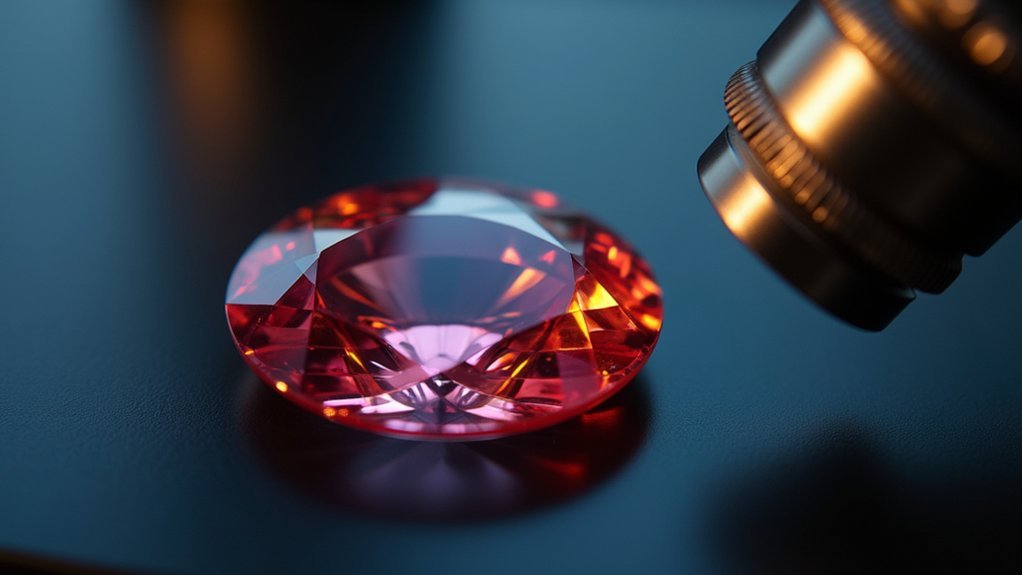

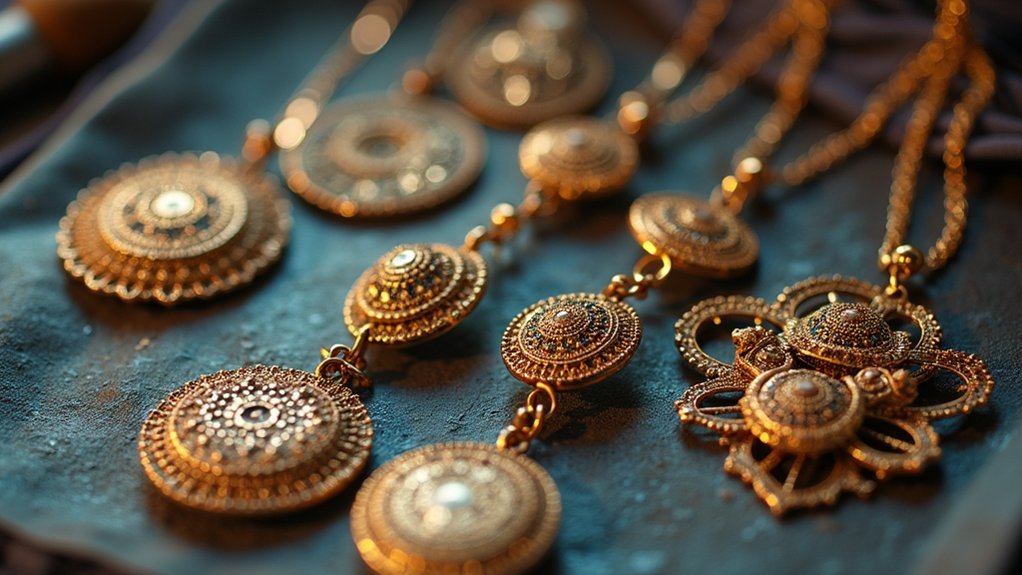
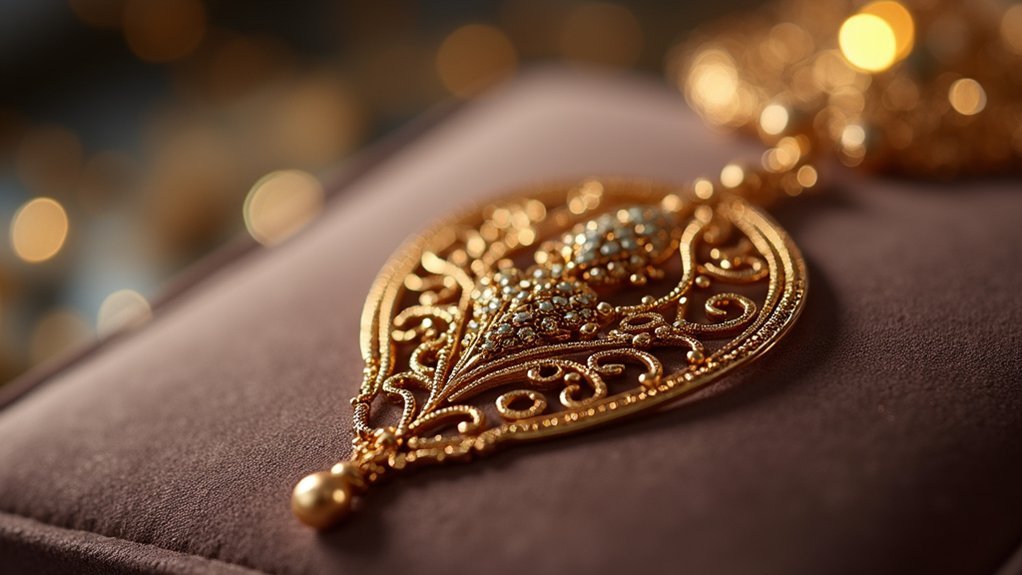
Leave a Reply